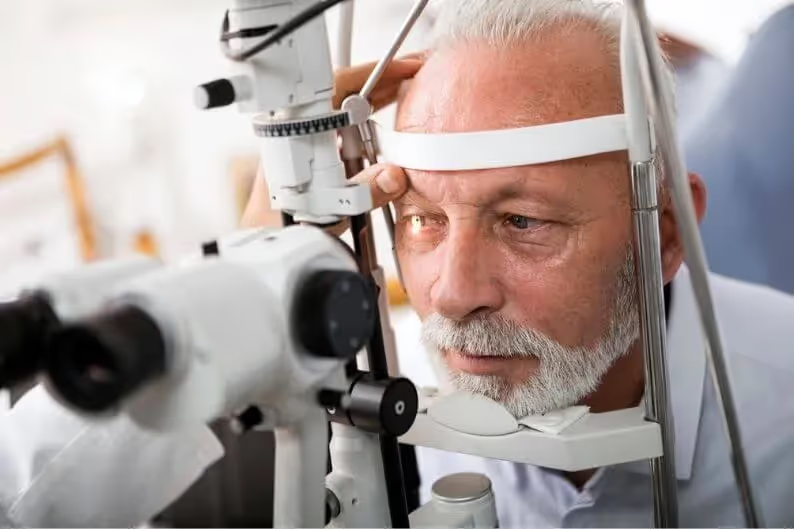Impairment of vision due to old age is very common. It's just a fact that as we get older our eyes tend to get weaker. The good news is there are a few common eye problems you can prevent or correct if you see an optometrist regularly. At the very least you can slow the progression of a serious disease if you're using proper prevention methods. Let's take a look at some of the most common vision problems.
Macular Degeneration
One of the leading causes of vision loss for people age 50 and older is age-related macular degeneration (AMD). This condition affects the part of your retina that's responsible for detailed vision (also known as central vision), like recognizing faces and reading. With AMD, the macula, which is the small portion in the middle of the retina that holds millions of nerve cells called cones. Those cones are sensitive to light. AMD causes the macula to become damaged, which leads to blurred or wavy vision and sometimes a blind spot. It usually does not cause total blindness, though. There are two types of this disease. The most common type is dry AMD. Small yellow deposits called drusen will form under the retina. The drusen can grow and stop nutrients from getting to the retina, which will cause the macula to die. The other type is called wet AMD. In this version, new blood vessels will grow under the retina. Those blood vessels will often break and start to leak, which causes vision loss. Those with a family history of AMD, people 60 years of age and above, Caucasians, females, those with light-colored eyes, smokers, and people dealing with heart disease, high blood pressure, high cholesterol, obesity, and a poor diet are at the highest risk. It's important to catch AMD in its early stages because there is currently no cure. If you catch it early on, you can slow the disease's progression with nutritional supplements. That's why regular trips to the eye doctor are important.
Glaucoma
Glaucoma is the second leading cause of blindness in the world and affects about 3 million Americans. It's a group of diseases that lead to vision loss and blindness due to increased pressure in the eye. Much of the time there are no symptoms to indicate you have glaucoma, which further underscores the importance of regular checkups. To be diagnosed with glaucoma, your optometrist will examine your eyes and look at the optic nerve. The provider will measure your eye pressure and test your visual field. The most at-risk people include African Americans older than 40, everyone older than 60, people with a family history of glaucoma, and those with diabetes. There's currently no cure for glaucoma, but early detection will allow you to get proper treatment to prevent the condition from getting worse. Medications like eye drops or pills can often treat glaucoma. Sometimes surgery is required to get the pressure in your eye under control.
Diabetic Retinopathy
As you may have guessed, this is a complication of diabetes. It happens when blood vessels start to leak and grow where they shouldn't. As this eye disease progresses, new blood vessels can grow and bleed into the center of your eye. That's when you'll end up with more serious vision loss or blindness. This disease can affect anyone with type 1 or type 2 diabetes. Symptoms can include:
- Spots or dark strings in your vision (called floaters)
- Blurred vision
- Fluctuating vision
- Dark or empty spots in your vision
- Vision loss
Drug injections and laser treatment can help improve or preserve vision. Prevention is really the key here. Maintaining your blood sugar and getting yearly eye exams with pupil dilation will put you in the best position.
Cataracts
Cataracts are the cloudy areas that develop in the lens of your eye. The lens is normally clear, which lets light easily pass through to the back of your eye. Cataracts prevent light from getting there, which causes blurred vision. It's kind of like you're looking through a fogged-up window in a car. A cataract forms because the lens in your eye gets thicker and less flexible as you get older. That combined with other medical conditions can cause the lens to break down and clump together. That's where you start to see the clouding. Some of the symptoms of cataracts include:
- Cloudy or blurred vision
- Increased difficulty with vision at night
- Sensitivity to light
- Needing brighter light for tasks like reading
- Seeing halos around lights
- Fading of colors
- Double vision in one eye
Risk factors include getting older, diabetes, smoking, obesity, high blood pressure, previous eye injury or surgery, and excessive drinking. On the bright side, cataract surgery is very common and extremely safe. The doctor can remove the clouded area and replace it with a clear plastic lens in most cases.
Other Issues
There are many other common eye problems that are less severe than the ones described above. Here are a few that you may experience.
Presbyopia
If you have to use readers, also known as cheaters, you're dealing with presbyopia. This is when you can't see things that are close up or read small print. This eye condition happens slowly over time, so you may notice it getting worse the older you get. People with presbyopia will often hold things at arms length when they're trying to read or get headaches while reading or doing tasks that require looking at things close up.
Floaters
Do you sometimes notice little specks or lines in your vision? You may notice them more often on a bright day or if you're in a well-lit room. Sometimes they can be an indicator of retinal detachment, but more often it's something normal to experience. You should consult your doctor if you notice a sudden change in the number of specks you're seeing.
Dry Eyes or Watery Eyes
This will occur when your tear glands either don't make enough tears or produce too many tears. In the case of dry eyes, you may be able to remedy the situation with a humidifier in your home or using eye drops. Sometimes surgery is necessary for more severe conditions. With watery eyes, you may just be dealing with a sensitivity to light, wind, or temperature changes. Using some type of glasses to shield your eyes often helps. However, you could be dealing with something like an eye infection or blocked tear duct, which your doctor can treat.
Preventing Age-Related Eye Problems
As is the case with many conditions, taking steps for prevention like eating a healthy diet, getting enough exercise, and seeing your doctor regularly is crucial to maintaining good eye health. Most of these common eye problems for older adults need to be found and treated early to prevent as much damage as possible.




